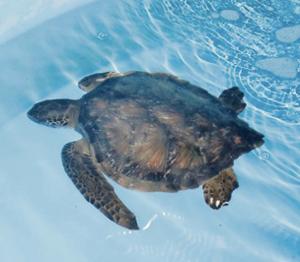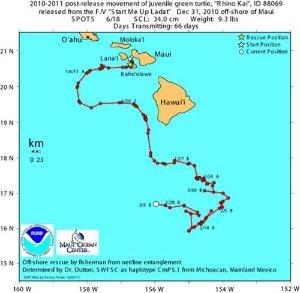Published in the Ocean Watch column, Honolulu Star-Advertiser © Susan Scott
March 28, 2011
When co-captains Ryan Fiedorowicz and Jason Duby of the Lahaina-based charter fishing boat Start Me Up Ladat saw splashes about eight miles south of Lanai in water about 1,000 feet deep, they knew something was wrong. The skippers, who had visitor anglers aboard, looped back to the disturbance and found a small sea turtle tangled in a cargo net, struggling for its life.
 George Balazs / National Marine Fisheries Service
George Balazs / National Marine Fisheries Service
Rhino Kai rests at the Maui Ocean Center.
While Ryan drove, Jason leaned over the side, cut the net and lifted the exhausted turtle aboard. The little creature was so worn out it couldn’t lift its head from the deck.
Ryan thought the turtle looked slightly different from Hawaii’s turtles, its shell darker and more pointed at the rear. He called Maui Ocean Center curator John Gorman, who contacted federal turtle biologist George Balazs. George gave permission to bring the rescued turtle ashore, and soon the 9-pound turtle was resting in its own tank at the Maui Ocean Center. Ryan, whose nickname is Rhino, named the tough little survivor Rhino Kai.
When George and colleagues arrived the next day to examine the youngster, they discovered through genetic testing that the turtle was indeed different. It came from Michoacán, a state in Mexico approximately the same latitude as Hawaii but more than 3,000 miles east.
Rhino Kai is the same species as Hawaii’s greens, but from a different genetic stock known as the East Pacific green turtle. Another common name is black turtle, due to its dusky shell.
Green turtles, by the way, are not green. The name comes from their green body fat.
Mexico’s black turtles probably swim this far offshore normally, but we see them in Hawaii only when they’re injured or caught in nets. Only two have been previously recorded in Hawaii’s waters, making Rhino Kai a rare celebrity.
After three days of rest, the 13-inch (shell length) turtle was ready to go back to its life at sea. George placed a satellite tag on the healthy animal’s shell, and Ryan and Jason returned it to the area where they found it. Ryan said that when they let go of the turtle, “it took off like a gunshot.”

Since the release on Dec. 31, Rhino Kai’s tiny transmitter has been showing the turtle’s zigzag course as it forages for food on the high seas. The device is expected to send this valuable information for about a year, but Rhino Kai will continue to eat and grow for up to 50 years (depending on food) before returning to Mexico to reproduce.
Aloha and good luck, Rhino Kai. We’re working on a solution to those lost nets.